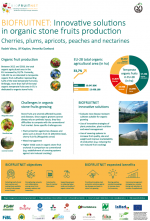PROJEKTETS MIDTVEJSRESULTATER
UNDERSØGELSER AF BEHOV, MANGLER OG PRAKSIS
A survey was conducted by BIOFRUITNET’ partners in order to identify the needs, the gaps and the practices in organic fruit production of pome fruits, stone fruits and citrus in Europe. The questionnaire was focused on plant health, functional biodiversity, soil and fertilization, varieties and rootstocks.
An online questionnaire was implemented in English, and national versions have been prepared for each country to facilitate the collection of information from respondents. The questionnaire was composed of one common part to all fruits species, and one part specific for each fruits species considered: apple, pear, apricot, peach, plum, cherry and orange.
From June to November 2021, 149 fruit growers and 100 technical advisors were surveyed in a total of 26 countries. 9 countries represent 80% of the respondents: Italy, France, Spain, Germany, Poland, Czech Republic, Austria, The Netherlands and Switzerland.

Origin of the respondents (%)
We collected 114 answers for apple, 44 for pear, 18 for plum, 10 for peach, 20 for cherry, 15 for apricot and 31 for orange.

Number of responses obtained for the 7 questionnaires dealing with a specific fruit species
The experience in organic fruit production for the farmers and advisors surveyed range respectively from 6 to 21 years and from 8 to 20 years. 79% of the farmers surveyed have 100% of their orchard grown in organic. The mean level of experience of the farmers surveyed seems high, in view of the current dynamics of the development of organic fruit production. The ‘organic part’ of the consultants represents 35 to 80% of their consulting activity.
Concerning fruit growers’ respondents, the median surface area of apple range from 1 and 30ha according to countries. For pear, the median surface area ranges from 1 to 7ha. For stone fruits, it ranges from 1 to 10ha with a high level of variability: from less than 1ha (e.g. Apricot in Austria and Switzerland, Peach in Poland) to 50ha (e.g. Peach in Spain) in farms. For citrus fruits, mainly orange, median surface area range from 2 to 15ha.
Concerning advisors’ respondents, The fruit-growing areas covered vary greatly depending on the country and the fruit species: from a few hectares to 1500ha. The few very high values, above 500ha, are observed for apples (fresh and processing), apricots, cherries (fresh and processing).
What media do you search for technical information?

Among the media used to search for technical information, the Internet is the most preferred tool, followed by conferences or documents in paper format. The written press in a foreign language is the least popular. The differences between countries provide interesting signposts: in countries where ‘Foreign documents’ represent less than 10% (ES, LV, NL, PL, PT, SE, TR), particular attention must be paid to the translation and/or accessibility of the documents produced, for example.
What are important interactive ways to get technical information?

Among the interactive ways of getting technical information, the exchange with an advisor or technician is the most frequent, followed by the exchange between farmers, open-field-days and meeting, and training. Social media are the less mentioned. These results show that the Biofruitnet project will have to carefully consider the target audience of advisors and technicians to enhance the dissemination.
What is your need for technical information (0: not important, 5: very important)?

The four topics mentioned as being of greatest concern are disease and pest control, knowledge of varieties and tree and soil nutrition. These topics also appear to be the most important for each fruit species. One small exception is “rootstock”, which appears among the four priority themes for peaches. It should be noted that no answer has an average score of less than 2: as expected, all topics must be well known to successfully manage an orchard!
Stone fruits
Data for apricot, peach, plum and cherry were collected from 15, 11, 18 and 20 respondents respectively. The interpretation of the following results should therefore be treated with caution due to the limited sampling for each fruit species.
Which pests are relevant, i.e. currently managed by practices, or not managed but commercially threatening the stone fruits production?
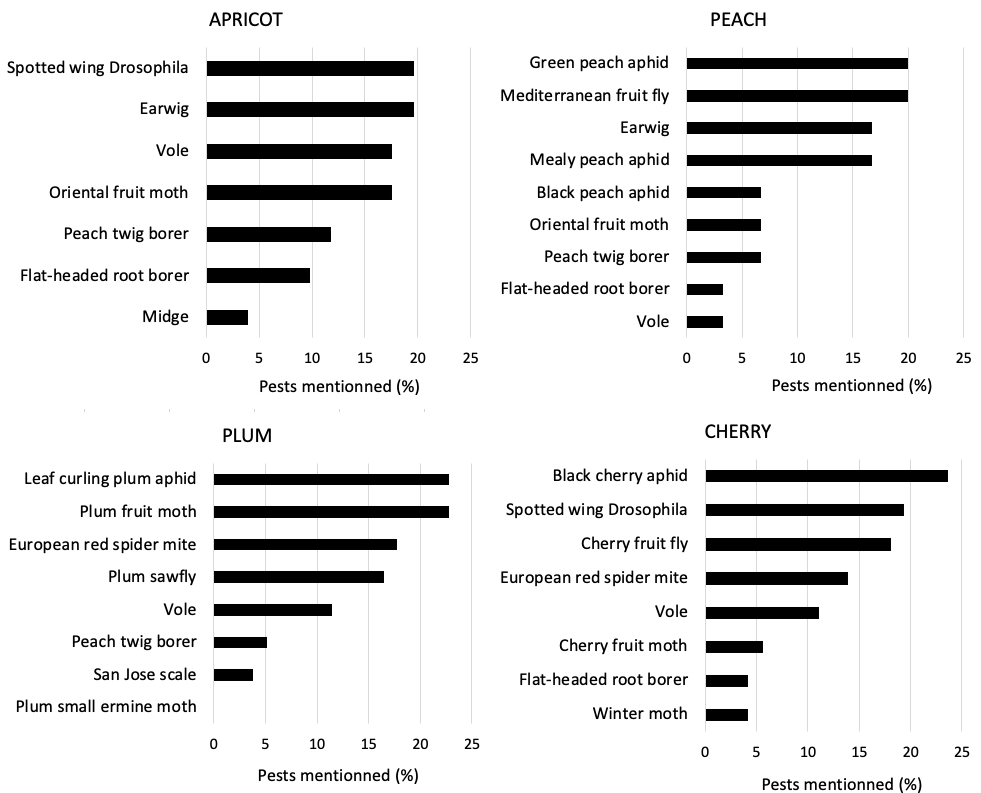
Respondenti kā būtiskus minēja no 7 līdz 9 kaitēkļiem katrai augļu sugai. No visvairāk pieminētajiem kauleņaugļu kaitēkļiem bija raibspārnu augļmušas drozofilas (aprikozes, ķirši), spīļastes (aprikozes, persiki) un dažādas laputu sugas (izņemot aprikozes). Peles tika minētas dažādās pakāpēs atkarībā no augļu sugas. Kauleņkoku krāšņvabole (Capnodis sp.) tika minēta pie trim sugām, kur tā var būt problēma (aprikozes, persiki un ķirši), taču diezgan zemā līmenī.

Which diseases are relevant, i.e. currently managed by practices, or not managed but commercially threatening the stone fruits production?

Between 8 and 15 diseases per fruit species were mentioned as relevant by the respondents. Among the diseases most mentioned for the 4 stone fruit species were Monilia spp. on blossoms, twigs and fruits. Bacterial canker diseases are also among the most occurrent diseases of concern. Virus diseases, especially plum pox virus (Sharka virus), were mentioned on apricot, peach and plum. Leaf rust was mentioned for the three species where it can be a problem (apricot, plum, cherry) at a limited proportion.

What is the dynamic of these pests in yours stone fruits orchards?

The graphic represents the proportion of responses obtained for each pest. Note: a constant pressure can be both low and high. “n” indicates the number of respondents for a given pest or disease. Only pests with at least 3 responses were considered. Most of the pests mentioned were seen as increasing or constant. Aphids and flies are an important part of the increasing pests . While the increasing pressure in spotted wing Drosophila is well documented, it is less known concerning other flies such as plum sawfly.
What is the dynamic of these diseases in yours stone fruits orchards?

The disease status in stone fruits appears to be mostly variable over time. Plum pox virus being a quarantine disease, the increase of its pressure in orchards is a worrying signal.
How important are the following criteria when planting a new cultivar for stone fruits?

The 64 growers and technical advisors surveyed were asked to rate the importance of criteria for the development and selection of stone fruits cultivars. All the criteria proposed in the questionnaire were considered important since they all obtained an average score of more than 3.5. For the four stone fruits, the most important criteria were fruit quality, pest and disease susceptibility and alternate bearing behaviour. For Apricot, autofertility was mentioned as an important trait.
How important are the following criteria when choosing a new rootstock for stone fruits?
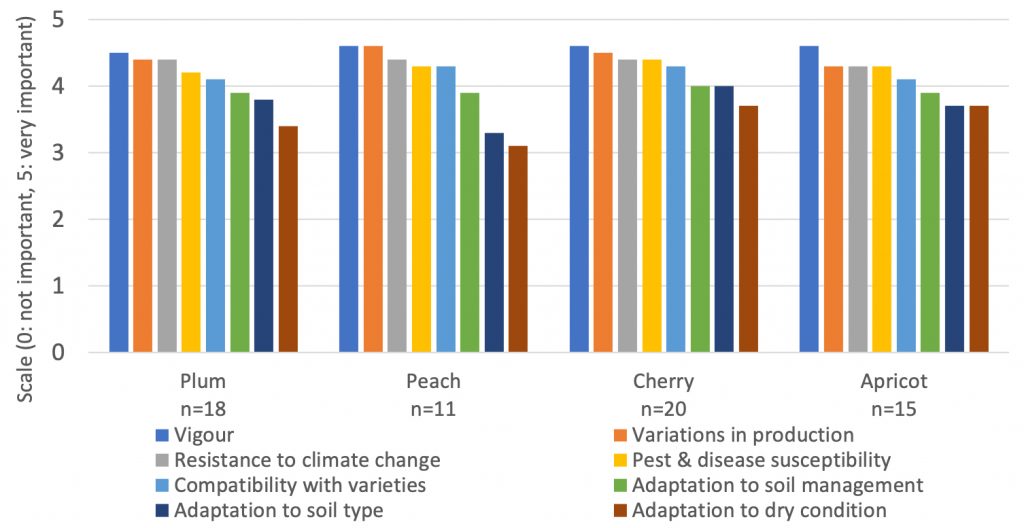
For rootstocks, the 8 criteria proposed were ranked in the same order whatever the stone fruits species considered. As expected, vigour control remains the first priority. Surprisingly, variation of production was mentioned as one of the most important criteria while some species (plum) are naturally more subject to alternate bearing behaviour than others (apricot, peach). Having rootstocks adapted to the future climate appears to be a major criteria.
Citrus
Data for citrus were collected by scrutinizing the answers obtained from 31 questionnaires belonging to 6 countries (Italy, Spain, Greece, Portugal, Morocco, and Austria). Italy and Spain aa the main organic citrus producers over the world, Morocco, Greece, and Portugal as emerging ones. Finally, Austria for its historical collection of lemons and oranges, mostly under glasshouses.
In this context, it is important to highlight that the limited answers received from Greece (4) and Italy (6) were due to the low production and lack of organic certified farms in Greece; whereas, in Italy, the main regions involved in citrus organic production are facing the same problems and have established an association’ producer model where the technical advisors are covering several orchards. Furthermore, due to the similarities between the pests and diseases of these two fruit species, the data obtained from the 28 responses for orange and 3 for lemon have been merged for this topic.
Which pests and diseases are relevant, i.e. currently managed by practices, or not managed but commercially threatening the citrus production?

The respondents to this questionnaire highlighted the difficulties encountered to control some pests and diseases, in particular, the Californian red scale, Mediterranean fruit fly, Citrus mealybug and the two-spotted mite as pests. Concerning disease control, up to the participants, Phytophthora was considered as the most problematic one, followed by Gummosis, Tristeza and Gray mold.
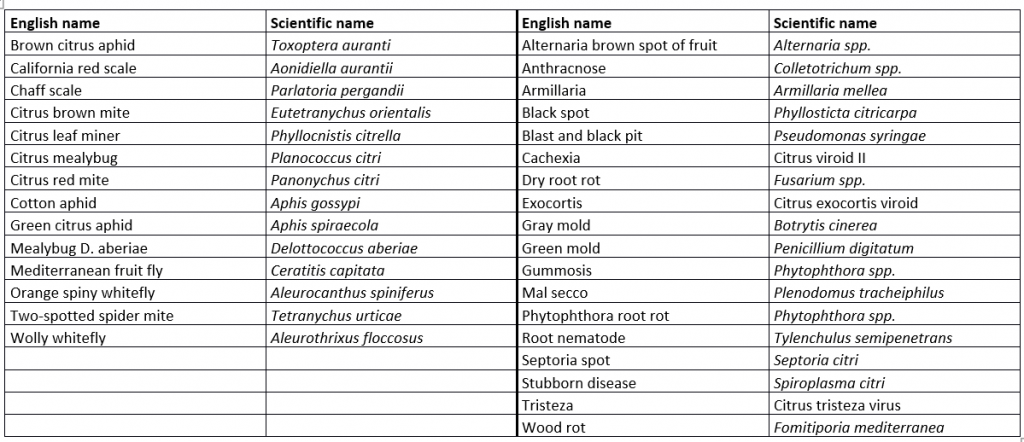
What is the dynamic of these pests and diseases in your citrus orchards?
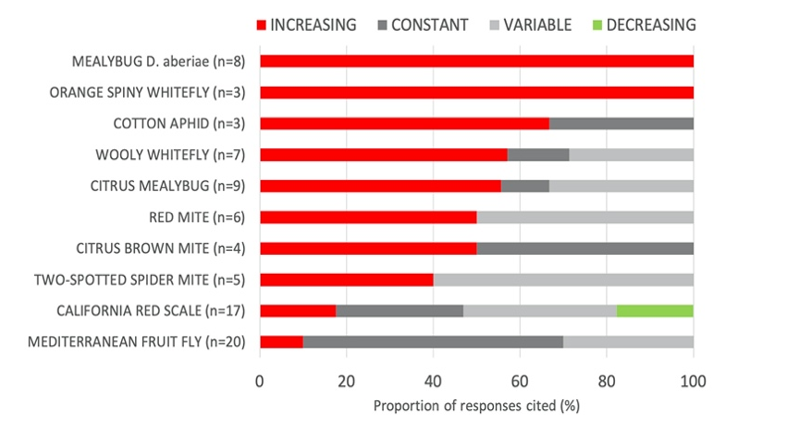

The respondents evidenced particular concerns about the new invasive pests who are seriously threatening the organic citrus production in the Euro-Mediterranean area. In this context, particular emphasis was given to the mealybug Delottococcus aberiae in Spain, the orange spiny whitefly in Italy and Greece, and the Brown citrus aphid in Spain and Portugal. Considering the lack of knowledge on these insect cycles and ecological behaviour, technical information for the different control measures was highly requested by the farmers/advisors.
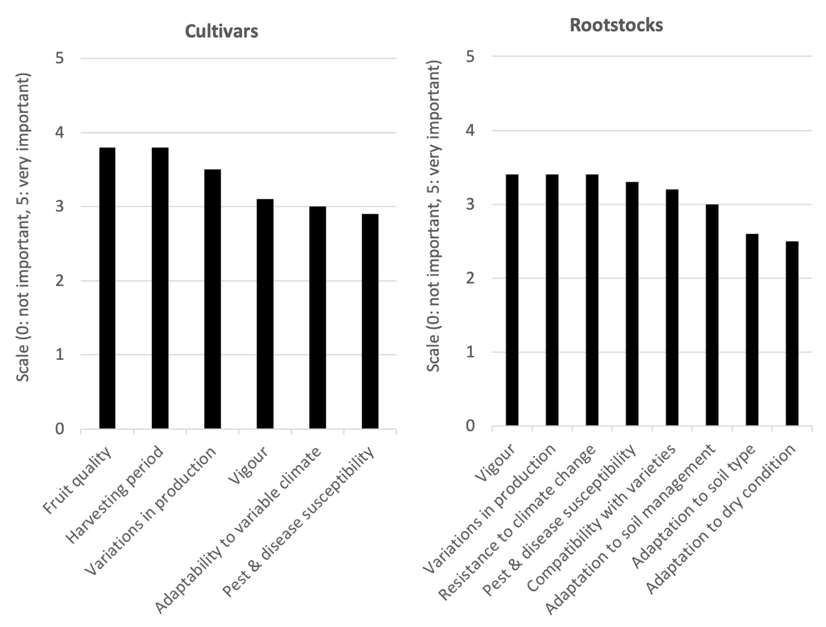
The respondents evidenced that the most important criteria to choose an orange cultivar are the fruit quality, harvesting period and alternate bearing behaviour. In contrast to pome and stone fruits, pest and disease susceptibility was mentioned as the less important. For rootstocks, the three main criteria mentioned were vigour, variations in production and resistance to climate change, at the same level of importance.
VIDENSKABELIG OG TEKNISK VIDEN
In the project BIOFRUITNET, nine search strings covering stone fruits, pome fruits and citrus fruits, within the selected main topics: pests, plant diseases and plant nutrition were developed, to target the most relevant scientific literature within the topics.
The bibliographic searches were conducted on October 19, 2020 in Web of Science. The databases presented are the complete lists of references included from the WoS search. These lists will be processed to select the most relevant materials ready for practice in a following project work package.
Consult the list scientific articles on organic fruit growing in the following LINK .
EVALUERING AF BEDSTE PRAKSIS
Your Content Goes Here
PRAKTISKE SAMMENDRAG
Kernefrugt
Stenfrugt
Citrusfrugt
Kommer snart, a href=”#newsletter”>tilmeld dig de seneste nyheder!
Online kurser. Kun på engelsk
Økologisk frugtproduktion er i hastig vækst og har en højere markedsværdi end konventionelle produkter. Det er også et udfordrende produktionssystem. Økologisk frugtproduktion er især udfordret af tab på grund af skadedyr og sygdomme, og mangel på information om management, egnede sorter og grundstammer.
I det europæiske projekt BIOFRUITNET er der blevet udviklet tre e-læringskurser, der dækker kernefrugt, stenfrugt og citrusfrugt, med det formål at nå ud til en bred vifte af elever og give den nyeste viden inden for bedste praksis for plantebeskyttelse i frugtplantager. Hvert af kurserne behandler aspekter af skadedyrsbekæmpelse, sygdomsbekæmpelse, funktionel agrobiodiversitet samt sorter og grundstammer.
Kurserne omfatter forskellige læringsformater, f.eks. diasshowpræsentationer, abstracts fra praksis og quizzer. Alt undervisningsmateriale kan downloades og bruges til egne undervisningsformål.
Klik på billedet for at få adgang til kurset
Denne præsentation beskriver fem vigtige skadedyr i æbleproduktion, deres symptomer og skader samt strategier til overvågning og bekæmpelse. En pdf-fil med slides kan downloades under videoen (voiceover af Lauren Dietemann).
Kurset består af fire dele:
- Del 1 – Strategier for skadedyrsbekæmpelse
- Del 2 – Strategier for sygdomsbekæmpelse
- Del 3 – Sorter og grundstammer
- Del 4 – Funktionel agrobiodiversitet
Klik på billedet for at få adgang til kurset
Økologisk produktion af stenfrugter
Dette kursus giver et overblik over udfordringer og værktøjer til bedste praksis inden for plantebeskyttelse i økologisk stenfrugtproduktion. Kurset er udviklet i det europæiske projekt BIOFRUITNET(åbner i en ny fane).
Kurset består af fem dele:
- Del 1: De vigtigste skadedyr og sygdomme i stenfrugt
- Del 2: Strategier for skadedyrsbekæmpelse
- Del 3: Strategier for sygdomsbekæmpelse
- Del 4: Sorter og grundstammer
- Del 5: Funktionel agrobiodiversitet (i kerne- og stenfrugtproduktion)
Kurset indeholder diasshowpræsentationer, abstracts fra praksis, quizzer og andet. Kurset skrider frem ved at trykke på ‘fortsæt’ efter hver aktivitet. Derudover kan undervisere downloade materialer til egne undervisningsformål.
Klik på billedet for at få adgang til kurset
Økologisk produktion af citrusfrugter
Dette kursus giver et overblik over udfordringer og værktøjer til bedste praksis inden for plantebeskyttelse i økologisk citrusfrugtproduktion. Kurset er udviklet i det europæiske projekt BIOFRUITNET .
Kurset består af tre dele:
- Del 1: Strategier for skadedyrsbekæmpelse
- Del 2: Nye plantesundhedsmæssige risici
- Del 3: Funktionel biodiversitet
Kurset indeholder diasshowpræsentationer, abstracts fra praksis, quizzer og andet. Kurset skrider frem ved at trykke på ‘fortsæt’ efter hver aktivitet. Derudover kan undervisere downloade materialer til egne undervisningsformål.
Klik på billedet for at få adgang til kurset




